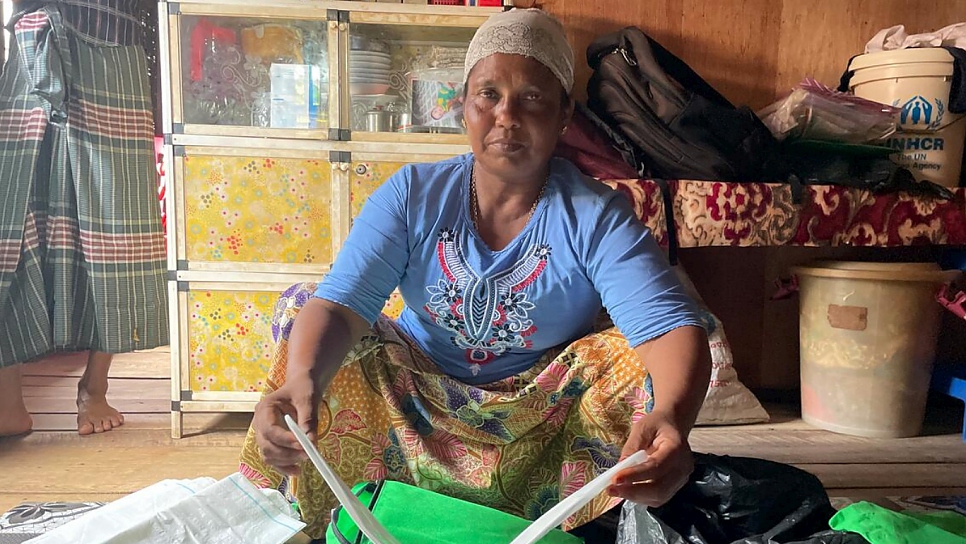Stateless Rohingya continue to struggle for survival in Myanmar
Five years after 700,000 Rohingya fled to Bangladesh, and a decade after intercommunal violence rocked Rakhine State, those who remain live in a state of limbo.

Za Beda with her daughter in Basara camp for internally displaced people near Sittwe in Myanmar's Rakhine State. © UNHCR/Reuben Lim Wende
Over the course of her life, Za Beda, a 27-year-old Rohingya woman living in Myanmar’s western Rakhine State, has had to adapt to increasing restrictions on her rights and freedoms.
In 2012, intercommunal clashes rocked Rakhine State. Za Beda was 17 at the time and had just started her own family. Together with tens of thousands of others, they were forced to flee.
A decade later, over 153,000 Rohingya like her remain displaced, the majority of them confined to camps. An additional 447,000 live in villages where they have little freedom of movement, affecting their ability to obtain healthcare, attend school or make a living. Another 700,000 Rohingya fled a further round of violence in 2017 and now live as refugees in Bangladesh and elsewhere in the region.
Restrictions on the amount of land the camps can occupy have meant that many are unable to expand to accommodate growing populations. Living in a crowded camp with limited sanitation facilitates and a growing family has brought hardships for Za Beda. “I have difficulties sleeping because there is not enough space for the eight of us in our shelter. I often go to my neighbour’s house to sleep,” she says.
Access to healthcare is an additional challenge. Now enduring a difficult pregnancy with her third child, Za Beda is unwilling to seek medical care due to a cumbersome and costly administrative process involving the need for approval from local administrators, male escorts, and navigating security checkpoints where extortion is common.
“I get upset when complications occur during childbirth,” says Hassinah Begom, a midwife who attends to the needs of Za Beda and other pregnant women in the camp. Despite not having had any formal training, she has successfully delivered over 500 children during her two-decade career and is often the first person mothers call on when they need assistance.
“In serious cases, I have to quickly accompany them to the hospital. We cannot leave if it is past 6pm because of the curfew. When we do go, only one person is allowed to accompany the patient, and we are not allowed to bring our phones. We also pay higher prices for medication,” says Begom. “Thankfully, no mother has died under my care.”
To improve living conditions and heal historical wounds, UNHCR, the UN Refugee Agency, and its partners have supported the Rohingya, Rakhine and other displaced communities in Rakhine State through distributions of household items, shelter reconstruction, livelihoods support and services. Such assistance is aimed at reducing vulnerabilities such as gender-based violence while promoting dialogue between different communities.
But policies such as denying equal access to citizenship and essential services, as well as movement restrictions, have kept the Rohingya marginalized and highly dependent on humanitarian aid. “No amount of aid is enough to solve the crisis,” says Federico Sersale, UNHCR’s head of office in Sittwe, the Rakhine state capital. “While it is imperative to assist, access to rights and freedoms, social cohesion between communities, the closure of camps, and allowing the Rohingya to return to their homes or places of choice are crucial to lasting solutions.”
Even after giving birth with little or no medical care, women living in the camps continue to worry for their children. Birth certificates are rarely issued to Rohingya children, a key document that provides them with a legal identity.
"It saddens me that none of the children born here have birth certificates."
Za Beda’s second child, who was born in the camp, never received a birth certificate. Her eldest child had one, but it was lost during the chaos of their displacement in 2012. “I’ve tried many ways to obtain a new one for him, but it has been impossible,” she says.
“It saddens me that none of the children born here have birth certificates. No one can grow up to be successful without one,” says Begom.
Determined to help as best she can, she has diligently recorded the date of birth for every child she has delivered. “My wish is for these records to help children obtain identity documents one day,” she says.
Restricting the Rohingya’s access to civil documents like birth certificates has long term consequences. As children grow up, they are unable to acquire other important identity documents such as national registration cards, leaving them legally and administratively invisible. This in turn jeopardizes their future prospects, limits their freedom of movement and traps them in a cycle of poverty and marginalization.
“The longer this situation persists, the more vulnerable and marginalized the Rohingya communities become. This will further diminish the prospects for those in Bangladesh who wish to return safely,” says UNHCR’s Federico Sersale.
Ajam Bibi, a 16-year-old living in the camp who Begom helped deliver as a baby, had to drop out of school at the age of 14 because her mother could not afford the fees. “I love to learn. If I have a chance to complete my studies, I will apply for a job with a humanitarian agency … Right now, I do chores and help my younger siblings with their studies," she says.
While primary education is often provided by humanitarian agencies for free inside camps, state-run high schools are often located far from camps and segregated from other communities. School fees and transportation costs add to the financial strain faced by cash-strapped families, a situation exacerbated by the lack of employment opportunities.
Reflecting on the difficulties faced in her own life and those of her children, Za Beda worries about the future. “I feel sad and unhappy with the situation … I cannot imagine what life will be like when the children grow up,” she says.


